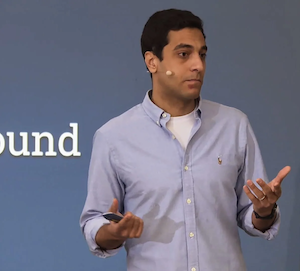 The server and mobile industries know open source well. But open source isn't just about the technology. First and foremost, open source is about sharing, and if there's one thing people love to share more than anything, it's self-expression in the form of art. Whether you consider yourself an artist or not, you can foster your own creativity with open source applications, and possibly end up with something you're proud to share with others. Here are 26 applications in seven different artistic categories to help you act on your every inspiration.
The server and mobile industries know open source well. But open source isn't just about the technology. First and foremost, open source is about sharing, and if there's one thing people love to share more than anything, it's self-expression in the form of art. Whether you consider yourself an artist or not, you can foster your own creativity with open source applications, and possibly end up with something you're proud to share with others. Here are 26 applications in seven different artistic categories to help you act on your every inspiration.
Opensource.com
See the following -
4 Ways Open Source Transformed Education In 2020
 The COVID-19 pandemic required a paradigm change in education in 2020, as face-to-face interaction between teachers and students was largely replaced by remote learning beginning in the spring. Opensource.com writers helped teachers, students, and families around the world rise to the challenge with examples of open software tools fueling innovation in teaching and learning. To document the transition to online instructions and help people adapt to it, our writers offer information about content-creation tools and lesson ideas that will keep teachers and students learning well into 2021 and beyond.
The COVID-19 pandemic required a paradigm change in education in 2020, as face-to-face interaction between teachers and students was largely replaced by remote learning beginning in the spring. Opensource.com writers helped teachers, students, and families around the world rise to the challenge with examples of open software tools fueling innovation in teaching and learning. To document the transition to online instructions and help people adapt to it, our writers offer information about content-creation tools and lesson ideas that will keep teachers and students learning well into 2021 and beyond.
- Login to post comments
10 Major Open Source News Headlines in 2020
 Throughout this past year, we've shared top open source news to keep everyone updated on what's happening in the world of open source. In case you missed any of the headlines, catch up on 10 of the open source news events that grabbed our readers' attention in 2020...When COVID-19 was declared a pandemic in March, in-person conferences and events around the world came to a halt. Although many were canceled or postponed, others moved to virtual formats with massive early success, reports Correspondent Alan Formy-Duval in his May news roundup. More than 80,000 people attended Red Hat Summit 2020 online in April, and GitHub Satellite saw 40,000 tune in from 178 countries. These were some of the biggest virtual conferences anywhere in 2020.
Throughout this past year, we've shared top open source news to keep everyone updated on what's happening in the world of open source. In case you missed any of the headlines, catch up on 10 of the open source news events that grabbed our readers' attention in 2020...When COVID-19 was declared a pandemic in March, in-person conferences and events around the world came to a halt. Although many were canceled or postponed, others moved to virtual formats with massive early success, reports Correspondent Alan Formy-Duval in his May news roundup. More than 80,000 people attended Red Hat Summit 2020 online in April, and GitHub Satellite saw 40,000 tune in from 178 countries. These were some of the biggest virtual conferences anywhere in 2020.
- Login to post comments
10 Ways Big Data And Data Science Impacted The World In 2020
 Big data’s one of many domains where open source shines. From open source alternatives for Google Analytics to new features in MySQL, 2020 brought several ways for open source enthusiasts to learn big data skills. Get up to speed on how open source data science languages, libraries, and tools help us understand our world better by reviewing the top 10 data science articles published on Opensource.com last year.
Big data’s one of many domains where open source shines. From open source alternatives for Google Analytics to new features in MySQL, 2020 brought several ways for open source enthusiasts to learn big data skills. Get up to speed on how open source data science languages, libraries, and tools help us understand our world better by reviewing the top 10 data science articles published on Opensource.com last year.
- Login to post comments
11 Ways To Get Involved With Humanitarian FOSS
 Lending a digital hand for humanitarian projects is just a click away. Whether you have five minutes or a few hours, you can make a difference with a variety of Humanitarian Free and Open Source Software (HFOSS) projects. The level of skills required vary from web search, verification, mapping, translation, training, and open source software development. Along the journey of changing the world, you can meet like minds and hone your skills. The key is to ask yourself: What do I want to do? How can I get started? How can I find the right project and community?
Lending a digital hand for humanitarian projects is just a click away. Whether you have five minutes or a few hours, you can make a difference with a variety of Humanitarian Free and Open Source Software (HFOSS) projects. The level of skills required vary from web search, verification, mapping, translation, training, and open source software development. Along the journey of changing the world, you can meet like minds and hone your skills. The key is to ask yourself: What do I want to do? How can I get started? How can I find the right project and community?
- Login to post comments
18 Ways To Differentiate Open Source Products From Upstream Suppliers
 Successful open source products must be able to charge a cost that is sufficient to pay for the defrayed upstream open source contributions (development costs) and the downstream productization costs (vendor costs). Stated another way, products can only charge a sufficient price if they create value that can only be captured by customers paying for them. That might sound harsh, but it's a reality for all products. There's a saying in product management: Pray to pay doesn't work. With that said, don't be too worried. There are ethical ways to capture value.
Successful open source products must be able to charge a cost that is sufficient to pay for the defrayed upstream open source contributions (development costs) and the downstream productization costs (vendor costs). Stated another way, products can only charge a sufficient price if they create value that can only be captured by customers paying for them. That might sound harsh, but it's a reality for all products. There's a saying in product management: Pray to pay doesn't work. With that said, don't be too worried. There are ethical ways to capture value.
- Login to post comments
2011 People's Choice Award: And the Winner is...
Thanks to everyone who voted for a People's Choice Award winner last week! [Now] that the votes are all in, we're pleased to announce that this year's winner is David Doria...In a very, very close second place was Abhi Nemani...Congratulations to David and Abhi. And thank you to both of you, as well as all of our nominees and every contributor. Read More »
- Login to post comments
26 open source creative apps to try in 2022
- Login to post comments
3 Ideas For Bringing Innersource To Your Company
 Like open source, innersource is all about being transparent and collaborative. This usually leads to a sense of belonging that favors employee happiness if done right. Regardless of org charts, geographies, or expertise levels, innersource creates an inclusive environment where employees contribute and collaborate in the open and learn from one another. When everyone defaults to transparency, silos tend to disappear, and employees save time by reusing code, processes, or best practices from different parts of the organization.
Like open source, innersource is all about being transparent and collaborative. This usually leads to a sense of belonging that favors employee happiness if done right. Regardless of org charts, geographies, or expertise levels, innersource creates an inclusive environment where employees contribute and collaborate in the open and learn from one another. When everyone defaults to transparency, silos tend to disappear, and employees save time by reusing code, processes, or best practices from different parts of the organization.
- Login to post comments
3 Key Open Source Challenges in Developing Countries
 When I go back home and talk to people in the tech industry, or any other industry for that matter, about what I do and the topics I'm involved in daily, I'm usually met with bemusement at the idea of an Open Source Programs Office (OSPO). The concept of a company contributing to an open source project without obvious immediate financial benefit can be culturally strange to understand or explain. As someone born and raised in a country that has been trying to develop for quite some time, I understand and relate to that. There was a point in time when my only understanding of open source was that it was software that I could use without paying and without needing to wait for a specific issue or additional feature to be released. I could just do whatever I needed myself, locally. Open source faces many struggles in developing countries that make how it's perceived and its associations inaccurate and out of touch. I will discuss these struggles in this article.
When I go back home and talk to people in the tech industry, or any other industry for that matter, about what I do and the topics I'm involved in daily, I'm usually met with bemusement at the idea of an Open Source Programs Office (OSPO). The concept of a company contributing to an open source project without obvious immediate financial benefit can be culturally strange to understand or explain. As someone born and raised in a country that has been trying to develop for quite some time, I understand and relate to that. There was a point in time when my only understanding of open source was that it was software that I could use without paying and without needing to wait for a specific issue or additional feature to be released. I could just do whatever I needed myself, locally. Open source faces many struggles in developing countries that make how it's perceived and its associations inaccurate and out of touch. I will discuss these struggles in this article.
- Login to post comments
3 Metrics To Measure Your Open Source Community Health
 Community building is table stakes in the success of any open source project. Even outside of open source, community is considered a competitive advantage for businesses in many industries—from retail, to gaming, to fitness. (For a deeper dive, see "When community becomes your competitive advantage" in the Harvard Business Review.) However, open source community building—especially offline activities—is notoriously hard to measure, track, and analyze. While we've all been to our fair share of meetups, conferences, and "summits" (and probably hosted a few of them ourselves), were they worth it? Did the community meaningfully grow? Was printing all those stickers and swags worth the money? Did we collect and track the right numbers to measure progress? To develop a better framework for measuring community, we can look to a different industry for guidance and fresh ideas: political campaigns.
Community building is table stakes in the success of any open source project. Even outside of open source, community is considered a competitive advantage for businesses in many industries—from retail, to gaming, to fitness. (For a deeper dive, see "When community becomes your competitive advantage" in the Harvard Business Review.) However, open source community building—especially offline activities—is notoriously hard to measure, track, and analyze. While we've all been to our fair share of meetups, conferences, and "summits" (and probably hosted a few of them ourselves), were they worth it? Did the community meaningfully grow? Was printing all those stickers and swags worth the money? Did we collect and track the right numbers to measure progress? To develop a better framework for measuring community, we can look to a different industry for guidance and fresh ideas: political campaigns.
- Login to post comments
3 Steps For Product Marketing Your Open Source Project
 Product marketing for COSS is materially different from product marketing for proprietary software and from general marketing practices like ads, lead generation, sponsorships, booths at conferences and trade shows, etc. Because the source code is open for all to see and the project's evolutionary history is completely transparent, you need to articulate—from a technical level to a technical audience—how and why your project works. Using the word "marketing" in this context is, in fact, misleading. It's really about product education. Your role is more like a coach, mentor, or teaching assistant in a computer science class or a code bootcamp than a "marketing person."
Product marketing for COSS is materially different from product marketing for proprietary software and from general marketing practices like ads, lead generation, sponsorships, booths at conferences and trade shows, etc. Because the source code is open for all to see and the project's evolutionary history is completely transparent, you need to articulate—from a technical level to a technical audience—how and why your project works. Using the word "marketing" in this context is, in fact, misleading. It's really about product education. Your role is more like a coach, mentor, or teaching assistant in a computer science class or a code bootcamp than a "marketing person."
- Login to post comments
4 Reasons Businesses Adopted Open Source In 2020
 Companies are turning to open source during the pandemic, with 44% of organizations reporting they will increase their use of open source for application development, finds Tidelift's third managed open source survey. We've heard this lyric before; in previous recessions, organizations turned to open source for cost savings and stayed for its other transformational benefits. We wanted to understand which long-term benefits were most helpful to organizations of different sizes. Here's a summary of what we found.
Companies are turning to open source during the pandemic, with 44% of organizations reporting they will increase their use of open source for application development, finds Tidelift's third managed open source survey. We've heard this lyric before; in previous recessions, organizations turned to open source for cost savings and stayed for its other transformational benefits. We wanted to understand which long-term benefits were most helpful to organizations of different sizes. Here's a summary of what we found.
- Login to post comments
6 Examples Of Open Source Best Practices In Knowledge-Sharing Projects
 The very effort of creating open source software is a massive knowledge-sharing experience, covering all the domains of software development with many methods and practices. Although there is rarely only one way to achieve a goal, open source communities have, over time, honed their knowledge into best practices as a natural byproduct of the open collaboration and transparency passed on within their respective communities. But what about best practices that span communities, which are useful beyond the unique needs of a single project and broadly applicable to any and all open source software efforts? I'll look at six different knowledge-sharing communities that take six approaches to gathering, maintaining, and distributing their best practices.
The very effort of creating open source software is a massive knowledge-sharing experience, covering all the domains of software development with many methods and practices. Although there is rarely only one way to achieve a goal, open source communities have, over time, honed their knowledge into best practices as a natural byproduct of the open collaboration and transparency passed on within their respective communities. But what about best practices that span communities, which are useful beyond the unique needs of a single project and broadly applicable to any and all open source software efforts? I'll look at six different knowledge-sharing communities that take six approaches to gathering, maintaining, and distributing their best practices.
- Login to post comments
6 remarkable features of the new United Nations open source initiative
 The United Nations wants to make technology, software, and intellectual property available to everyone, including developing countries. Open source and free software are great tools to achieve this goal since open source is all about empowering people and global collaboration while protecting the personal data and privacy of users. So, the United Nations and the open source community share the same values. This new open source strategy and policy is developed by the United Nations Technology Innovation Labs (UNTIL). Last month, we had our first in-person meeting in Helsinki in the UNTIL offices. I find this initiative remarkable for several reasons:
The United Nations wants to make technology, software, and intellectual property available to everyone, including developing countries. Open source and free software are great tools to achieve this goal since open source is all about empowering people and global collaboration while protecting the personal data and privacy of users. So, the United Nations and the open source community share the same values. This new open source strategy and policy is developed by the United Nations Technology Innovation Labs (UNTIL). Last month, we had our first in-person meeting in Helsinki in the UNTIL offices. I find this initiative remarkable for several reasons:
- Login to post comments
7 Ways Open Source was Essential to Business in 2020
 The COVID-19 pandemic created many new challenges for businesses in 2020 as they rapidly moved non-essential workers to remote operations. However, it also created tremendous opportunities for innovation as people searched for effective ways to work and collaborate virtually. Opensource.com responded to the need by publishing a variety of articles in 2020 on working better with open source. Since it appears working remotely is here to stay for the foreseeable future, make sure you're doing everything you can to adapt by reading the top seven articles about open source business from 2020.
The COVID-19 pandemic created many new challenges for businesses in 2020 as they rapidly moved non-essential workers to remote operations. However, it also created tremendous opportunities for innovation as people searched for effective ways to work and collaborate virtually. Opensource.com responded to the need by publishing a variety of articles in 2020 on working better with open source. Since it appears working remotely is here to stay for the foreseeable future, make sure you're doing everything you can to adapt by reading the top seven articles about open source business from 2020.
- Login to post comments